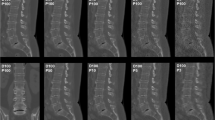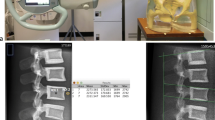Abstract
Objective
To compare image quality of a standard-dose (SD) and a low-dose (LD) cervical spine CT protocol using filtered back-projection (FBP) and iterative reconstruction (IR).
Materials and methods
Forty patients investigated by cervical spine CT were prospectively randomised into two groups: SD (120 kVp, 275 mAs) and LD (120 kVp, 150 mAs), both applying automatic tube current modulation. Data were reconstructed using both FBP and sinogram-affirmed IR. Image noise, signal-to-noise (SNR) and contrast-to-noise (CNR) ratios were measured. Two radiologists independently and blindly assessed the following anatomical structures at C3–C4 and C6–C7 levels, using a four-point scale: intervertebral disc, content of neural foramina and dural sac, ligaments, soft tissues and vertebrae. They subsequently rated overall image quality using a ten-point scale.
Results
For both protocols and at each disc level, IR significantly decreased image noise and increased SNR and CNR, compared with FBP. SNR and CNR were statistically equivalent in LD-IR and SD-FBP protocols. Regardless of the dose and disc level, the qualitative scores with IR compared with FBP, and with LD-IR compared with SD-FBP, were significantly higher or not statistically different for intervertebral discs, neural foramina and ligaments, while significantly lower or not statistically different for soft tissues and vertebrae. The overall image quality scores were significantly higher with IR compared with FBP, and with LD-IR compared with SD-FBP.
Conclusion
LD-IR cervical spine CT provides better image quality for intervertebral discs, neural foramina and ligaments, and worse image quality for soft tissues and vertebrae, compared with SD-FBP, while reducing radiation dose by approximately 40 %.





Similar content being viewed by others
References
Freund M, Sartor K. Degenerative spine disorders in the context of clinical findings. Eur J Radiol. 2006;58:15–26.
Douglas-Akinwande AC, Rydberg J, Shah MV, et al. Accuracy of contrast-enhanced MDCT and MRI for identifying the severity and cause of neural foraminal stenosis in cervical radiculopathy: a prospective study. AJR Am J Roentgenol. 2010;194:55–61.
Tins B. Technical aspects of CT imaging of the spine. Insights Imaging. 2010;1:349–59.
Biswas D, Bible JE, Bohan M, Simpson AK, Whang PG, Grauer JN. Radiation exposure from musculoskeletal computerized tomographic scans. J Bone Joint Surg Am. 2009;91:1882–9.
Lee TY, Chhem RK. Impact of new technologies on dose reduction in CT. Eur J Radiol. 2010;76:28–35.
Tamm EP, Rong XJ, Cody DD, Ernst RD, Fitzgerald NE, Kundra V. Quality initiatives: CT radiation dose reduction: how to implement change without sacrificing diagnostic quality. Radiographics. 2011;31:1823–32.
Hoang JK, Yoshizumi TT, Nguyen G, et al. Variation in tube voltage for adult neck MDCT: effect on radiation dose and image quality. AJR Am J Roentgenol. 2012;198:621–7.
Leswick DA, Hunt MM, Webster ST, Fladeland DA. Thyroid shields versus z-axis automatic tube current modulation for dose reduction at neck CT. Radiology. 2008;249:572–80.
Gervaise A, Louis M, Batch T, et al. Dose reduction at CT of the lumbar spine using a 320-detector row scanner: initial results. J Radiol. 2010;91:779–85.
Singh S, Kalra MK, Hsieh J, et al. Abdominal CT: comparison of adaptive statistical iterative and filtered back projection reconstruction techniques. Radiology. 2010;257:373–83.
Pontana F, Pagniez J, Flohr T, et al. Chest computed tomography using iterative reconstruction vs filtered back projection (Part 1): evaluation of image noise reduction in 32 patients. Eur Radiol. 2011;21:627–35.
Moscariello A, Takx RA, Schoepf UJ, et al. Coronary CT angiography: image quality, diagnostic accuracy, and potential for radiation dose reduction using a novel iterative image reconstruction technique-comparison with traditional filtered back projection. Eur Radiol. 2011;21:2130–8.
Winklehner A, Karlo C, Puippe G, et al. Raw data-based iterative reconstruction in body CTA: evaluation of radiation dose saving potential. Eur Radiol. 2011;21:2521–6.
Wirth S, Meindl T, Treitl M, Pfeifer KJ, Reiser M. Comparison of different patient positioning strategies to minimize shoulder girdle artifacts in head and neck CT. Eur Radiol. 2006;16:1757–62.
Mulkens TH, Marchal P, Daineffe S, et al. Comparison of low-dose with standard-dose multidetector CT in cervical spine trauma. AJNR Am J Neuroradiol. 2007;28:1444–50.
Deak PD, Smal Y, Kalender WA. Multisection CT protocols: sex- and age-specific conversion factors used to determine effective dose from dose-length product. Radiology. 2010;257:158–66.
Bongartz G, Golding SJ, Jurik AG, et al. European guidelines on quality criteria for computed tomography. EUR 16262 http://www.drs.dk/guidelines/ct/quality/index.htm accessed October 13, 2011.
Jones B, Jarvis P, Lewis JA, Ebbutt AF. Trials to assess equivalence: the importance of rigorous methods. BMJ. 1996;313:36–9.
Brenner DJ, Hall EJ. Computed tomography–an increasing source of radiation exposure. N Engl J Med. 2007;357:2277–84.
Gervaise A, Osemont B, Lecocq S, et al. CT image quality improvement using Adaptative Iterative Dose Reduction with wide-volume acquisition on 320-detector CT. Eur Radiol. 2012;22:295–301.
Dougeni E, Faulkner K, Panayiotakis G. A review of patient dose and optimisation methods in adult and paediatric CT scanning. Eur J Radiol. 2012;81:e665–83.
Acknowledgements
The authors thank Julien G. Ott for his help with the noise power spectrum analysis.
Conflict of interest
The authors declare that they have no conflict of interest.
Funding or grant
None
Author information
Authors and Affiliations
Corresponding author
Rights and permissions
About this article
Cite this article
Becce, F., Ben Salah, Y., Verdun, F.R. et al. Computed tomography of the cervical spine: comparison of image quality between a standard-dose and a low-dose protocol using filtered back-projection and iterative reconstruction. Skeletal Radiol 42, 937–945 (2013). https://doi.org/10.1007/s00256-013-1576-9
Received:
Revised:
Accepted:
Published:
Issue Date:
DOI: https://doi.org/10.1007/s00256-013-1576-9




